Everything You Need to Know About Pet Parakeets
If you're deciding on the best pet bird for your household, consider a parakeet. Also known as budgies, these small birds love to play, talk, and socialize — making them an ideal option for first-time bird parents.
Plus they flaunt a variety of pretty color options.
We visited with Dr. Sabrina Kong, DVM, a staff veterinarian at We Love Doodles. She's spent years volunteering at avian rescues and rehabilitating parakeets. At home, she's mom to Skittles, a much-loved and spoiled parakeet.
"Parakeets are the ultimate charmers. They bond deeply with owners, often perching on shoulders or mimicking phrases like 'pretty bird,'" she shared. "But don't let their size fool you. They're clever problem-solvers that thrive on interaction. Skittles once learned to unclip his habitat door ¦ twice."
Note: The term parakeet can refer to a wide range of parrots. For this article, we focus on the popular parakeet pet known as a Budgerigar (Melopsittacus undulatus), or budgie.
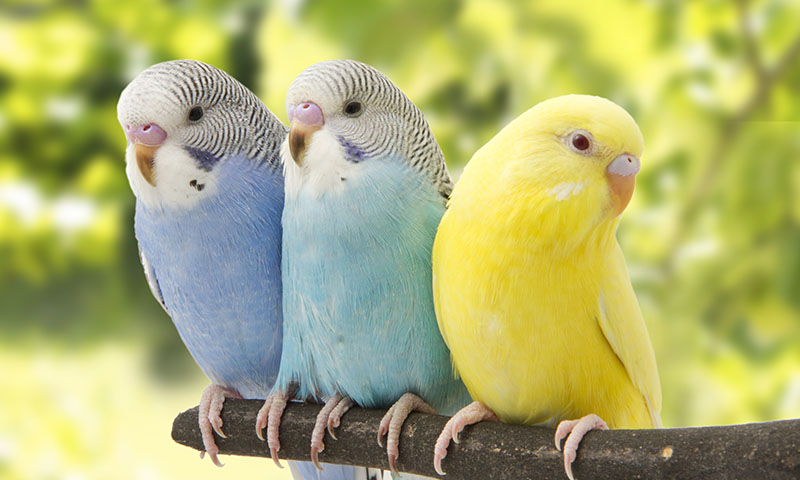
Three parakeets, or budgies, sitting on a perch.
What Colors Are Parakeets?
In the wild, parakeets have vibrant green and yellow feathers. However, captive breeding has added blues, whites, and violet hues to the mix.
Some of the most popular colors of budgies include:
-
Sky blue: This pet has beautiful light blue feathers, purple cheek patches, and dark bars on the wings and head.
-
Light green: This is the traditional coloring seen in wild parakeets. A vibrant lime green chest, yellow and black barred wings and head, and blue-purple cheek spots make this bird attractive.
-
Cobalt: These budgies look similar to the sky blues, but have a darker hue of blue on the bodice and an even darker blue on the tail.
-
Violet: If you've always loved light lavender colors, you'll find them on this bird's chest. Black and white stripes on the wings and head provide a stunning contrast.
-
White: As the name suggests, these little birds look like all-white snowballs. Some may have a small random patch of color.
-
Yellow: This budgie features lemon yellow feathers with muted gray barring on the head and wings. Occasionally, green patches show on the undersides.
Parakeets also sport unique markings. Some male birds have iridescent blue cheek spots. And some parakeets feature striped patterns on their heads.
Kong says her favorite unique mutation (or variation) is the lacewing parakeet with its soft pastel-colored feathers and bright red eyes, giving it a ghostly appearance.
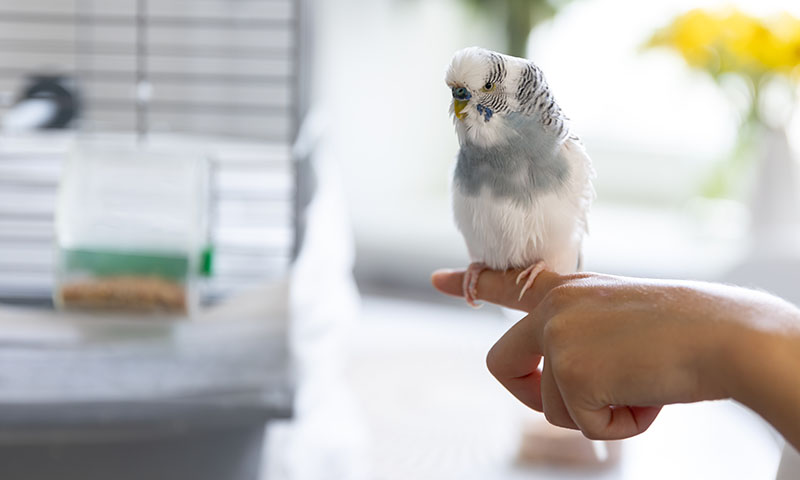
A blue and white parakeet perched on a child's finger.
How Big Do Parakeets Get?
As you shop for a parakeet, you'll come across juveniles measuring around 4 inches in length. Adults grow to approximately 7 to 8 inches, from beak to tail.
When it comes to housing a parakeet, Kong says the best aviary sits horizontally to allow for short flights. It should measure about 18" wide by 18" deep and 24" tall with bar spacing at 1/2" wide to prevent escape.
Place the habitat away from the kitchen, where non-stick pans and appliances, such as air fryers, are used, as these give off toxic fumes. Parakeets may also have sensitivities to artificial fragrances (room sprays, scented candles), smoke (cigarettes, incense, candles), and similar products that release particles into the air.
In the wild, parakeets flock in thousands. Domesticated pet parakeets still crave this social connection, which means you may want to consider housing two or more birds together in a larger, longer aviary. To prevent unwanted breeding, choose two or more birds of the same sex.
Inside the habitat, you'll need bowls for food and water, a variety of perch sizes and styles to exercise your pet's feet, and toys. Yes, parakeets like to play!
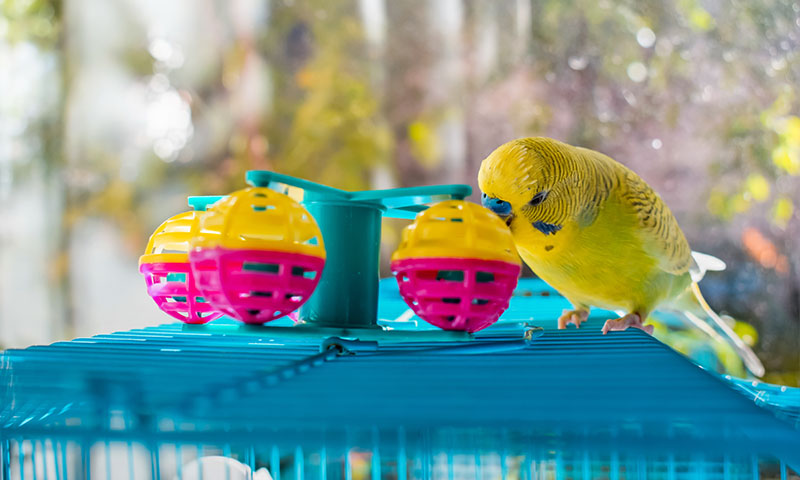
A green-yellow budgie playing on top of his aviary.
Do Parakeets Like Toys?
Parakeets not only like toys, they need them for stimulation. Kong says parakeets have great emotional depth and enjoy mental challenges.
She suggests offering your pet parakeet shreddable toys made from clean cardboard or palm leaves.
"Parakeets also thrive on puzzles, like foraging toys made from repurposed cardboard tubes stuffed with millet. It's a budget-friendly way to mimic wild behaviors and curb boredom-driven feather plucking," Kong shared.
Parakeets enjoy ringing bells with their beaks, gliding on bird swings, gazing into tiny mirrors, and climbing miniature ladders.
Kong's parakeet, Skittles, loves deconstructing and shredding a simple toy made from straws threaded through an empty toilet paper roll.
What Sounds Do Parakeets Make?
Don't let their small stature fool you. Parakeets can sing, talk, and tweet!
"They're tiny maestros! They make morning chirps ("Wake up!"), melodic songs for contentment, and mimicry of household sounds (microwaves, laughter)," Kong explained. "Males often talk more clearly. Skittles greets me with 'Hey, Doc!' every evening, a relic of my clinic days."
While parakeets don't speak as clearly as larger birds, such as macaws, they do mimic words they hear around the house. So, choose your vocabulary wisely! If you want your parakeet to say a specific word or phrase, simply repeat it to your bird often and wait for him to say it back to you. You can use the same process for teaching your bird to make a specific whistling sound that you enjoy hearing.
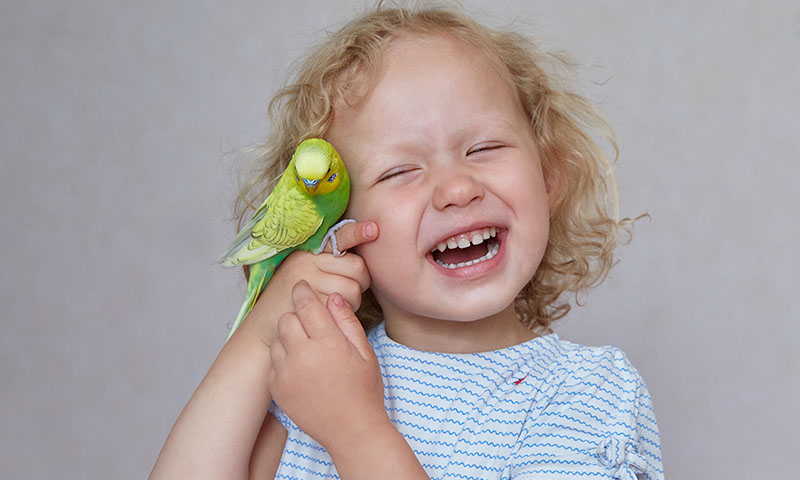
Girl bonding with her pet parakeet.
How Can I Bond With My Parakeet?
All pet birds require attention, and doing so will boost your connection.
When you first bring your pet parakeet home, give him a few days to acclimate to his new surroundings, people, and routine. With all the changes in his world, he may become suspicious and try to bite. Avoid sudden movements and let the bird familiarize himself with his new home.
Then create a daily routine that allows you and your bird to bond over familiar tasks, including refilling fresh water, offering new food, and tidying up the aviary.
Kong says the key to bonding with your new parakeet is consistency. She recommends spending at least 30 minutes each day talking softly to your bird near his aviary, offering treats, such as millet, by hand to build trust and eventually working on teaching tricks, such as "step-up" onto your finger or target training so they touch a specific object with their beak.
Consider working on these tricks too:
Eventually, you'll learn your bird's personality, as well as their likes and dislikes. Most parakeets enjoy spending time directly with their human parent.
"Skittles and I have TV time nightly as he perches on my laptop, critiquing veterinary dramas," Kong added.

Blue and white budgie eating from a treat stick.
What Do I Feed My Parakeet?
All pet birds require a balanced, healthy diet and access to fresh, clean water.
Parakeets specifically have a habit of dunking food (and sometimes poop ... yuck!) in their water bowl. This helps to soften hard foods. Keep an eye on their water supply. You may need to dump the dirty water, then wash their water bowl with soap and water, and rinse with clear water before refilling it with fresh drinking water twice per day.
When it comes to food, parakeets thrive on a mix of pellet bird food (70%) and fresh produce (30%) with seeds as an occasional treat.
Parakeets love to snack on uncooked, shredded carrots and apples. You can also offer spinach leaves, whole berries, and little "trees" of broccoli for your pet to shred and eat.
For the main diet, consider one of these tasty parakeet foods.
-
Kaytee NutriSoft Parakeet & Cockatiel Food: This pellet food has a soft texture that mimics the ripe fruits and vegetables your pet would find in the wild. It's formulated with essential nutrients to support digestive, brain, heart, feather, and skin health. (Try this food if your bird is a frequent "water dunker.")
-
Kaytee Exact Rainbow Parakeet & Lovebird Food: If your parakeet loves to crunch hard foods, try this firm pellet food. It's formulated with the nutrition your pet needs for optimal health, including maintaining bright feathers.
-
Kaytee Forti-Diet Pro Health Egg-Cite Parakeet Food: Grains and seeds, as well as dried whole egg, as an extra source of protein and vitamins, make up this food mix. Offer your parakeet this blend during molting (a natural shedding of feathers) or when breeding.
-
Kaytee Fiesta Parakeet Food: Is your parakeet extra playful? He will love digging through the variety of shapes, textures, and ingredients in this combination of fruits, pellets, grains, vegetables, and seeds.
Just like us, parakeets enjoy an occasional treat. Your bird buddy might go wild for a Kaytee Honey Treat Stick clipped onto the side of his aviary or a small dish of Kaytee Veggie & Fruit Treat for Parakeet during your bonding time together.
What Is a Parakeet's Lifespan?
With proper care, regular veterinary check-ups, and daily socializing, your pet parakeet can live about 10 to 15 years, Kong explained.
Parakeets can experience adverse health conditions. Kong says annual veterinarian visits can check for diseases early.
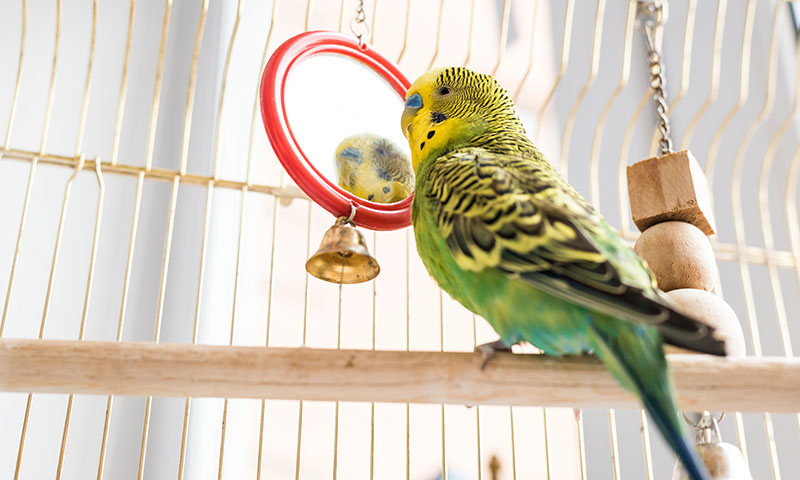
Green and yellow parakeet looking at itself in a toy mirror.
Parakeets Make Great Pets
If you're interested in a small, colorful parrot as your new BFF, consider a parakeet. They love to socialize with humans, don't take up much space, and can mimic your favorite words. Plus, parakeets make wonderful pets for first-time bird parents.
Learn more about budgies in Tips For Parakeet Care and Bonding.
